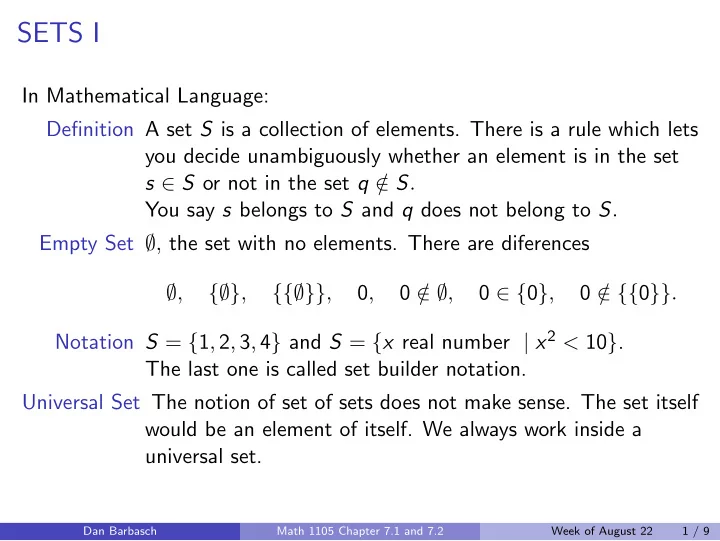

SETS I In Mathematical Language: Definition A set S is a collection of elements. There is a rule which lets you decide unambiguously whether an element is in the set s ∈ S or not in the set q / ∈ S . You say s belongs to S and q does not belong to S . Empty Set ∅ , the set with no elements. There are diferences ∅ , {∅} , {{∅}} , 0 , 0 / ∈ ∅ , 0 ∈ { 0 } , 0 / ∈ {{ 0 }} . Notation S = { 1 , 2 , 3 , 4 } and S = { x real number | x 2 < 10 } . The last one is called set builder notation. Universal Set The notion of set of sets does not make sense. The set itself would be an element of itself. We always work inside a universal set. Dan Barbasch Math 1105 Chapter 7.1 and 7.2 Week of August 22 1 / 9
Other Notions and Operations on Sets Inclusion S ⊂ T . Every element of S is an element of T . Equality S = T S ⊂ T and T ⊂ S . The order in which the elements are listed does not count. Two sets are equal precisely when they have the same elements. Symbols ⊂ �⊂ , ⊃ Intersection ∩ logical “and”. Disjoint Sets. Union ∪ logical “or” c logical “not” Complement Dan Barbasch Math 1105 Chapter 7.1 and 7.2 Week of August 22 2 / 9
EXAMPLE 8 Stocks The following table gives the 52-week low and high prices, the closing price, and the change from the previous day for six stocks in the Standard & Poor’s 100 on February 19, 2010. Source: New York Stock Exchange. New York Stock Exchange Stock Low High Close Change AT&T 21.44 28.73 25.10 Ϫ 0.55 Coca-Cola 37.44 59.45 55.72 Ϫ 0.34 FedEx 34.02 92.59 81.76 ϩ 2.07 McDonald’s 50.44 65.75 64.74 ϩ 0.40 PepsiCo 45.39 64.48 62.66 ϩ 0.21 Walt Disney 15.14 32.75 31.23 ϩ 0.68 Dan Barbasch Math 1105 Chapter 7.1 and 7.2 Week of August 22 3 / 9
Let the universal set U consist of the six stocks listed in the table. Let A be the set of all stockswith a high price greater than $80 , B the set of all stocks with a closing price between $40 and $105, C the set of all stocks with a positive price change, and D all stockswith a low price less than $40 Find a A c b A ∩ C c B ∪ D Dan Barbasch Math 1105 Chapter 7.1 and 7.2 Week of August 22 4 / 9
fi fi fi fi Tree Diagrams and Counting I Given a finite set, list all subsets and count how many there will be without having to list them. Subset a in su b s et? b in su b s et? c in su b s et? Yes {a, b, c} Yes No {a, b} Yes Yes {a, c} No {a} No Yes {b, c} Yes No {b} No Yes {c} No ~ No (b) Find the subsets of {a, b, c}. FIGURE 1 Dan Barbasch Math 1105 Chapter 7.1 and 7.2 Week of August 22 5 / 9
Venn Diagrams I 44. Blood Antigens Human blood can contain the A antigen, the B antigen, both the A and B antigens, or neither antigen. A third antigen, called the Rh antigen, is important in human reproduction, and again may or may not be present in an individual. Blood is called type A-positive if the individual has the A and Rh but not the B antigen. A person having only the A and B antigens is said to have type AB-negative blood. A per- son having only the Rh antigen has type O-positive blood. Other blood types are defined in a similar manner. Identify the blood types of the individuals in regions (a) (h) below. Dan Barbasch Math 1105 Chapter 7.1 and 7.2 Week of August 22 6 / 9
fi fi fi fi fi fi fi fi fi U A B (b) (a) (c) (e) (d) (f) (g) Rh (h) Dan Barbasch Math 1105 Chapter 7.1 and 7.2 Week of August 22 7 / 9
45. Blood Antigens (Use the diagram from Exercise 44.) In a certain hospital, the following data were recorded. 25 patients had the A antigen; 8 had the A and not the B antigen; 27 had the B antigen; 22 had the B and Rh antigens; 30 had the Rh antigen; 12 had none of the antigens; 16 had the A and Rh antigens; 15 had all three antigens. How many patients a. were represented? b. had exactly one antigen? c. had exactly two antigens? d. had O-positive blood? e. had AB-positive blood? f. had B-negative blood? g. had O-negative blood? h. had A-positive blood? Dan Barbasch Math 1105 Chapter 7.1 and 7.2 Week of August 22 8 / 9
Recommend
More recommend